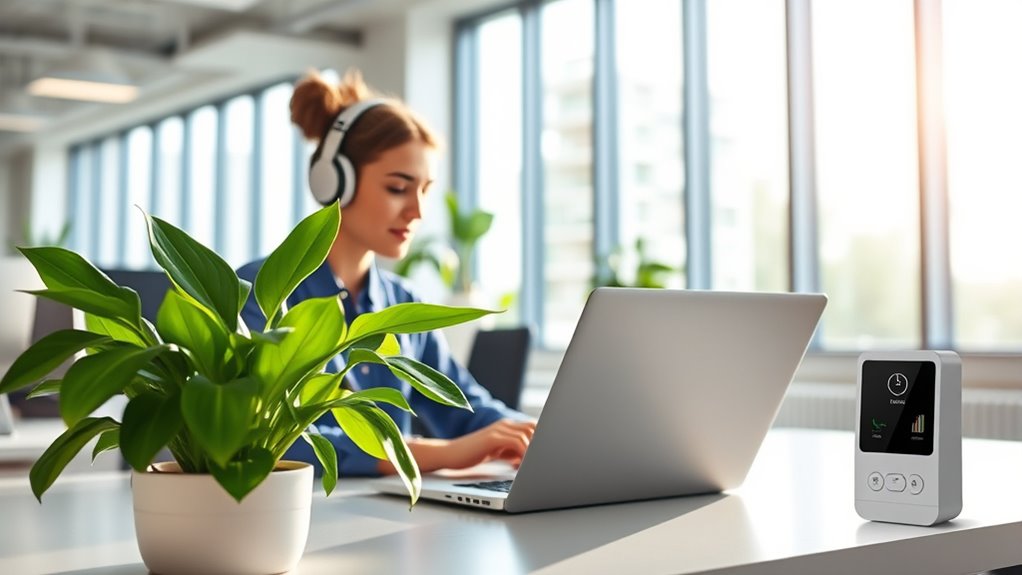Poor indoor air quality can substantially reduce your focus, energy, and overall productivity. When pollutants like dust, VOCs, or CO₂ build up, you may experience fatigue, headaches, or difficulty concentrating. Proper ventilation, air purifiers, and fresh airflow are key to improving air quality and maintaining mental clarity. By enhancing your workspace’s environment, you support better health and efficiency—discover more ways to optimize your indoor environment and boost your performance.
Key Takeaways
- Poor indoor air quality reduces cognitive function, concentration, and overall task performance.
- Elevated levels of CO₂, VOCs, and dust impair mental clarity and cause fatigue.
- Enhanced ventilation and air purification significantly improve productivity and occupant well-being.
- Long-term exposure to indoor pollutants can lead to health issues that decrease work efficiency.
- Proper IAQ management creates healthier, more alert work environments, boosting employee performance.

Have you ever wondered how the air inside your workspace affects your efficiency? It’s a question worth considering because indoor air quality (IAQ) plays a vital role in how well you perform your daily tasks. Poor air quality can lead to fatigue, headaches, and decreased concentration, all of which hinder productivity. One effective way to improve IAQ is through ventilation improvements that focus on pollutant control. By ensuring proper airflow, you help dilute and remove harmful contaminants, creating a healthier environment that keeps you alert and focused.
Ventilation improvements are essential because they directly influence the concentration of indoor pollutants. When your workspace isn’t properly ventilated, pollutants such as dust, volatile organic compounds (VOCs), carbon dioxide, and other airborne toxins tend to accumulate. This buildup can cause symptoms like dizziness, difficulty concentrating, and even long-term health issues. Implementing better ventilation systems—like adding exhaust fans, air purifiers with HEPA filters, or increasing outdoor air exchange—can markedly reduce these risks. Pollutant control becomes more manageable when you prioritize ventilation, making sure that fresh air constantly replaces stale indoor air.
Imagine working in a room with poor airflow—you’re likely to feel sluggish, distracted, or even irritable. Now picture the opposite: a well-ventilated space where pollutants are effectively managed. You’ll notice improved mental clarity, reduced fatigue, and a sense of overall well-being. Ventilation improvements don’t just involve mechanical systems; simple measures like opening windows or using air circulators can also make a difference, especially in moderate climates. The key is to guarantee a steady flow of fresh air, preventing the stagnation that allows pollutants to linger.
In addition to mechanical upgrades, controlling sources of indoor pollution is critical. Reducing clutter, avoiding tobacco smoke, and choosing low-emission office supplies contribute to pollutant control. Regular maintenance of HVAC systems and replacing filters on schedule further enhance airflow and pollutant removal. These efforts all work together to optimize IAQ, fostering a workspace that promotes productivity rather than hampers it with poor air quality. Ensuring proper ventilation systems are in place and functioning correctly is fundamental for maintaining a healthy indoor environment.
Ultimately, prioritizing ventilation improvements and pollutant control isn’t just about comfort—it’s about your ability to perform at your best. When you breathe cleaner air, your mind stays sharper, your energy levels stay higher, and your overall health benefits. Making these adjustments can seem minor but have a profound impact on your daily efficiency, proving that good indoor air quality is a cornerstone of productivity.
Frequently Asked Questions
How Does Humidity Affect Indoor Air Quality and Worker Health?
Humidity levels directly affect indoor air quality and your respiratory health. When humidity is too high, it fosters mold growth and dust mites, which can cause allergies and respiratory issues. Conversely, low humidity can dry out your respiratory passages, making you more vulnerable to infections. Maintaining ideal humidity levels, around 40-60%, helps keep the air comfortable and promotes better respiratory health, ultimately supporting your overall well-being and productivity indoors.
What Role Do Plants Play in Improving Indoor Air Quality?
Imagine your workspace as a garden; plants are the natural air purifiers that improve indoor air quality. You’ll find plant benefits include filtering toxins and increasing oxygen levels, which boost your focus and well-being. Studies show certain indoor plants can remove harmful chemicals like formaldehyde. By adding greenery, you create a healthier environment, making it easier to breathe and stay productive—just like a well-tended garden nurtures growth.
Can Air Purifiers Significantly Boost Employee Productivity?
You might wonder if air purifiers can really boost employee productivity. Air purifier effectiveness varies, but many models reduce pollutants and allergens, creating cleaner indoor environments. When air quality improves, you’ll likely notice increased focus, fewer sick days, and better overall performance. So, investing in a quality air purifier can be a smart move to enhance your workplace productivity, especially if indoor air quality has been a concern.
How Do Building Materials Influence Indoor Air Pollution Levels?
Think of building materials as the lungs of your space—they breathe out emissions that can cloud your indoor air quality. Materials with high emissions release volatile organic compounds over time, impacting air purity. Durability matters too, as durable materials tend to emit fewer pollutants long-term. Choosing low-emission, sturdy building materials helps keep your indoor air cleaner, supporting better health and productivity in your environment.
What Is the Long-Term Impact of Poor Indoor Air Quality on Cognitive Function?
Poor indoor air quality can have serious long-term effects on your brain, leading to neurodegenerative effects and chronic cognitive decline. You might notice memory lapses, difficulty concentrating, and slower thinking over time. Continuous exposure to pollutants increases your risk of developing neurodegenerative diseases like Alzheimer’s. To safeguard your cognitive health, guarantee good ventilation and reduce indoor pollution sources. Taking these steps helps preserve your mental sharpness now and in the future.
Conclusion
By improving indoor air quality, you enhance focus, boost efficiency, and elevate well-being. Clearer air fosters sharper thinking, healthier bodies, and a more positive mood. When you prioritize clean air, you create an environment where productivity flourishes, creativity thrives, and success becomes inevitable. Remember, quality air isn’t just a comfort—it’s a catalyst for your best work, your best health, and your best life. Make clean air your foundation for growth, for achievement, for excellence.









